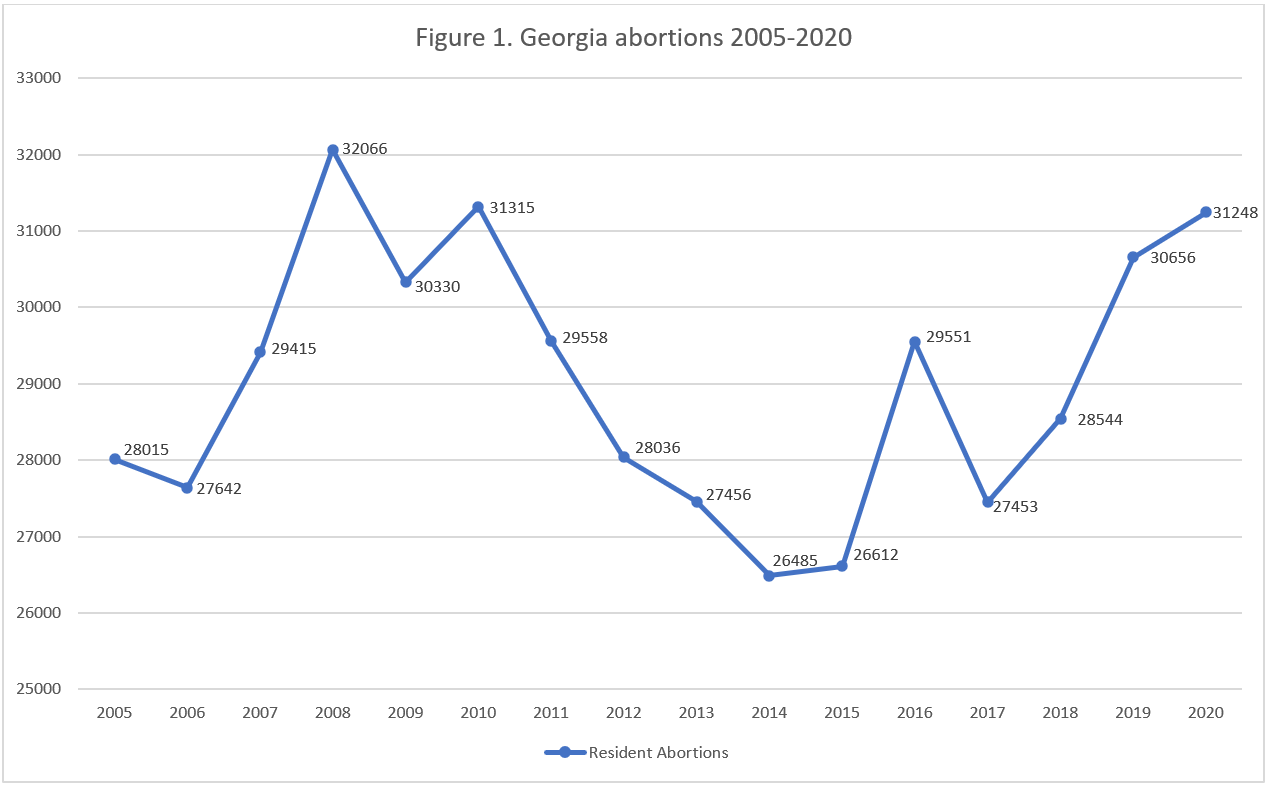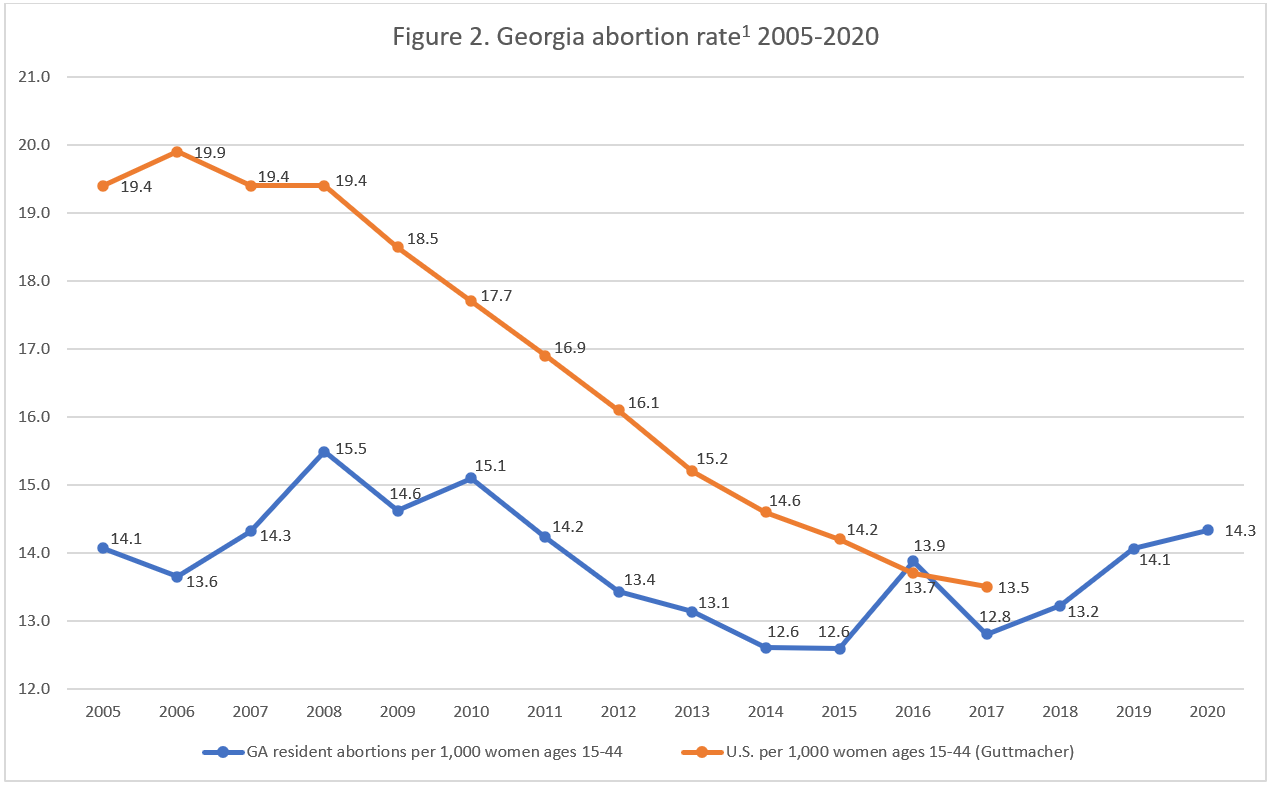Abortion Reporting: Georgia (2020)
Georgia released its 2020 abortion statistics in its online vital statistics database in July 2021. Georgia resident abortions increased from the previous year.
Changes in Georgia Abortions, 2019-2020

The report does not include information on Planned Parenthood’s Georgia abortion market share.
Abortion Totals and Trends
In 2020, there were 31,248 abortions reported to have been performed on Georgia residents, both inside and outside Georgia. This was an increase of two percent from 2019, when 30,656 Georgia resident abortions were reported. Georgia did not report chemical abortion statistics. The Charlotte Lozier Institute (CLI) estimates that Georgia’s 2020 abortion rate was 14.3 abortions per 1,000 women ages 15 to 44, up two percent from the previous year, higher than the most recent estimate for the national rate (Fig. 2). As of July 2021, 16 states had released 2020 abortion statistics, of which nine reported that abortions increased.
Georgia’s abortion data is available in OASIS, which includes abortions performed on Georgia residents in other states but does not include abortions on nonresident women performed in Georgia. The OASIS system cautions that North Carolina did not share any abortion data with Georgia in 2020, despite reporting an average 134 abortions on Georgia residents in the previous four years.
State Report Summary
Seven percent of Georgia resident abortions were performed on girls in their teens or younger; two percent were on girls between the ages of 10 and 17. Twenty-seven percent were on women in their early twenties, and 31 percent were on women in their later twenties. Thirty-one percent were obtained by women in their thirties, and four percent were performed on women ages 40 to 55.
In 2020, 66 percent of Georgia resident abortions were performed on black women, even though black women make up only 37 percent of all Georgia resident women between the ages of 15 and 44. A fifth of the abortions were on white women, and three percent were on Asian women. There were 64 abortions (0.2 percent) on American Indian or Alaska Native women, and there were 33 abortions (0.1 percent) on Native Hawaiian or other Pacific Islander women. Two percent of the abortions were obtained by multiracial women. Race was not reported for nine percent of the abortions.
Georgia reports ethnicity separate from race, and in 2020, 88 percent of Georgia resident abortions were performed on non-Hispanic women. Nine percent were on Hispanic women, and two percent were on women of unknown ethnicity.
2018 CDC Report
Georgia’s OASIS database does not provide information on the pregnancy history or marital status of women undergoing abortions, and it does not include all abortions performed in the state; abortions performed on nonresidents are excluded. However, Georgia shares these statistics with the Centers for Disease Control and Prevention (CDC) to be included in the CDC’s annual abortion surveillance reports. The most recent report published by the CDC is for 2018.
According to the 2018 data Georgia shared with the CDC, three-quarters of all abortions occurring in Georgia were performed on unmarried women, 12 percent were on married women, and 13 percent were on women whose marital status was not reported.
Forty-five percent of the abortions reported in Georgia in 2018 were obtained by women with no previous live births. Twenty-three percent were performed on women with one prior live birth, and 33 percent were on women with two or more previous live births. Sixty-four percent of the abortions were performed on women with no previous abortions, while 22 percent of the abortions were on women with one prior abortion and 14 percent were on women with more than one.
Thirty-nine percent of the abortions occurring in Georgia were performed at six weeks of gestation or earlier. Thirty-eight percent occurred between seven and eight weeks, and 14 percent were performed between 10 and 13 weeks of gestation. Three percent were reported between 14 and 15 weeks, and two percent each were performed between 16 and 17 weeks and 18 and 20 weeks. There were 259 abortions, less than one percent of the total, performed at 21 weeks of gestation or later. Georgia limits abortion at 20 weeks post-fertilization, around 22 weeks of gestation.
State Ranking
In CLI’s 2016 paper on abortion reporting across the country, Georgia’s reporting tied for 25th best. To improve its reporting, Georgia could include all the information it provides to the CDC, including the pregnancy history and marital status of women getting abortions, the gestational ages at which abortions are performed, and the types of abortion procedures used. Georgia could also include data for all abortions performed in the state and report the states to which Georgia residents travel for abortions.


- Rates were calculated by CLI using the following formula: (abortions performed on Georgia residents ÷ number of resident women ages 15-44) x 1,000. Rates may differ slightly from previous CLI articles due to revised population estimates. Population estimates were obtained from the CDC WONDER database.

























